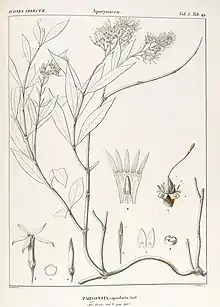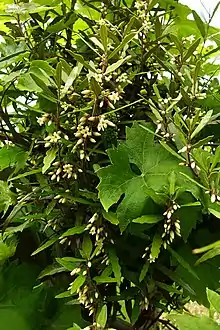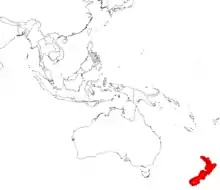| Parsonsia capsularis | |
|---|---|
 | |
| Icones selectae plantarum, vol. 5: t. 49 (1846) artist: J.C. Heyland | |
 | |
| Parsonsia capsularis | |
| Scientific classification | |
| Kingdom: | Plantae |
| Clade: | Tracheophytes |
| Clade: | Angiosperms |
| Clade: | Eudicots |
| Clade: | Asterids |
| Order: | Gentianales |
| Family: | Apocynaceae |
| Genus: | Parsonsia |
| Species: | P. capsularis |
| Binomial name | |
| Parsonsia capsularis | |
 | |
| Occurrence data from GBIF | |
Parsonsia capsularis is a climbing plant endemic to New Zealand belonging to the dogbane family Apocynaceae.[3]
The common names for the plant are New Zealand jasmine or small flowered jasmine, and in Māori it has several names including: akakaikiore, akakiore, kaikū, kaikūkū, kaiwhiria, tōtoroene and tōtorowene.
Despite its common name, the species is not a "true jasmine" and not of the genus Jasminum.
Taxonomy
Parsonsia capsularis was first named and described as Periploca capsularis by Georg Forster in 1786[2][4] and in 1809 was assigned by Robert Brown to his newly described genus, Parsonsia.[1][2]
Etymology
The specific epithet, capsularis. derives from the Latin, capsula (small box - capsule) and means bearing capsules, producing capsules, or capsular-fruited.[5]
See also
References
- 1 2 Flora of New Zealand: Parsonsia capsularis. Retrieved 25 December 2018.
- 1 2 3 Brown, R. (1809) Memoirs of the Wernerian Natural History Society. i. 65
- ↑ "Parsonsia capsularis var. capsularis". New Zealand Plant Conservation Network. Retrieved 10 November 2012.
- ↑ Forster, G. (1786) Florulae insularum Australium :prodromus 20. Retrieved 25 December 2018
- ↑ Plantillustrations.org Parsonsia capsularis. Retrieved 25 December 2018.